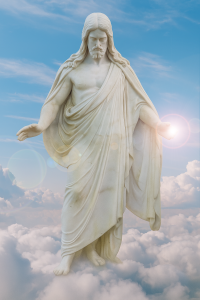 The veil that separates mortality from the world of spirits is not impermeable. It is thin, sacred, and at times perceptible to the eye of faith. For members of the Church, this is central to our theology of eternal families, temple covenants, and the gathering of Israel on both sides of the veil. We declare with assurance that our ancestors are not lost in oblivion, nor are they dormant in death. They dwell in a realm close to our own—a state of awareness, purpose, and continued progression.
The veil that separates mortality from the world of spirits is not impermeable. It is thin, sacred, and at times perceptible to the eye of faith. For members of the Church, this is central to our theology of eternal families, temple covenants, and the gathering of Israel on both sides of the veil. We declare with assurance that our ancestors are not lost in oblivion, nor are they dormant in death. They dwell in a realm close to our own—a state of awareness, purpose, and continued progression.
This understanding is illuminated in the Scriptures. The Apostle Paul testified: “Wherefore seeing we also are compassed about with so great a cloud of witnesses, let us lay aside every weight…and let us run with patience the race that is set before us” (Hebrews 12:1). This “cloud of witnesses” includes our righteous forebears, whose testimonies and faith surround us still. Though departed from the flesh, they yet remain part of the eternal family of God, deeply interested in our salvation and efforts on their behalf.
The Book of Mormon affirms the continued identity and consciousness of the soul after death. In Alma 40:11–12 we read, “Now, concerning the state of the soul between death and the resurrection—Behold, it has been made known unto me by an angel, that the spirits of all men, as soon as they are departed from this mortal body, yea, the spirits of all men, whether they be good or evil, are taken home to that God who gave them life. And then shall it come to pass, that the spirits of those who are righteous are received into a state of happiness, which is called paradise, a state of rest, a state of peace, where they shall rest from all their troubles and from all care, and sorrow.” But paradise is not merely a passive resting ground. In a later revelation to President Joseph F. Smith, this truth is further opened: “I beheld that the faithful elders of this dispensation, when they depart from mortal life, continue their labours in the preaching of the gospel…among those who are in darkness” (Doctrine and Covenants 138:57).
Thus, the faithful on the other side of the veil are active. They are teaching, organising, ministering, and watching. They are present not only as observers, but as ministers of the Lord’s ongoing work. They have not ceased to love us. Indeed, their concern may now be keener, purified of worldly distraction and animated by divine charity.
“When the physical body dies, the spirit continues to live. In the spirit world, the spirits of the righteous ‘are received into a state of happiness, which is called paradise, a state of rest, a state of peace, where they shall rest from all their troubles and from all care, and sorrow’ (Alma 40:12).” (True to the Faith: A Gospel Reference [2004], 46). This spiritual nearness is a doctrinal reality. The spirit world is here, not in some faraway corner of the universe, but a parallel realm, invisible to our natural senses, yet intimately tied to our own.
Malachi’s prophecy, reiterated by the angel Moroni to Joseph Smith, testifies to the sacred mission that unites both worlds: “And he shall turn the heart of the fathers to the children, and the heart of the children to their fathers” (Malachi 4:6; 3 Nephi 25:6). This work of turning hearts is covenantal. It is fulfilled in the temple, wherein ordinances are performed that bind the generations of mankind into an eternal family sealed by the priesthood.
 The Lord revealed this purpose plainly to the Prophet Joseph Smith in Doctrine and Covenants 128:15: “And now, my dearly beloved brethren, let me assure you that these are principles in relation to the dead and the living that cannot be lightly passed over…for their salvation is necessary and essential to our salvation.” He continues, “They without us cannot be made perfect—neither can we without our dead be made perfect” (v. 15).
The Lord revealed this purpose plainly to the Prophet Joseph Smith in Doctrine and Covenants 128:15: “And now, my dearly beloved brethren, let me assure you that these are principles in relation to the dead and the living that cannot be lightly passed over…for their salvation is necessary and essential to our salvation.” He continues, “They without us cannot be made perfect—neither can we without our dead be made perfect” (v. 15).
Therefore, when we gather genealogical records, attend the House of the Lord, and perform baptisms, confirmations, endowments, and sealings for the dead, we are not performing rituals for strangers. We are labouring in love for family. Those very individuals, now living in the spirit world, are made aware of our sacrifices on their behalf. They are not indifferent. They feel, hope, and watch.
The Prophet Elijah’s return in Kirtland’s temple, as recorded in Doctrine and Covenants 110, signified that the dispensation of the fulness of times would include a mighty labour to unite the family of Adam—past and present—in sacred covenants. This is central to the Gospel. It is, in fact, the work of salvation and exaltation.
To those who mourn, to those who wonder whether their loved ones still care, whether they still exist, or whether they still feel, the testimony of modern prophets is sure: they do. The veil has not erased them. It has refined them.
President Russell M. Nelson said, “Your worship in the temple and your service there for your ancestors will bless you with increased personal revelation and peace and will fortify your commitment to stay on the covenant path.” (“As We Go Forward Together,” Liahona, April 2018, 7.)
In sacred moments—in prayer, in quiet grief, in the stillness of the temple—we may feel impressions, warmth, or assurance that they are near. Though such feelings must never supplant doctrine or curiosities, they may testify of the Spirit’s witness that death does not destroy eternal relationships.
Indeed, the Lord Jesus Christ Himself taught, “God is not the God of the dead, but of the living” (Luke 20:38). He who broke the bands of death and opened the way for resurrection and eternal life is the very one who declares, “I am the resurrection and the life: he that believeth in me, though he were dead, yet shall he live” (John 11:25).This promise is made possible only through the atonement of Christ, which bridges all gaps—of sin, of time, and of death. Through Him, every righteous desire to be reunited with loved ones will be fulfilled. The ordinances of the temple are the authorised means by which these reunions are guaranteed, sealed by the power of the Holy Melchizedek Priesthood, and ratified by the Spirit of Promise.
 Thus, the veil is not an end but a gate. Our ancestors await the day of resurrection with eager hope, even as they labour in spirit to prepare others for the same. We live in sacred partnership with them. When we honour our covenants, we honour theirs. When we teach our children truth, we extend the legacy of those who first embraced it. And when we kneel at the altars of the temple, we kneel not alone—but with generations.
Thus, the veil is not an end but a gate. Our ancestors await the day of resurrection with eager hope, even as they labour in spirit to prepare others for the same. We live in sacred partnership with them. When we honour our covenants, we honour theirs. When we teach our children truth, we extend the legacy of those who first embraced it. And when we kneel at the altars of the temple, we kneel not alone—but with generations.
Let us therefore live with reverence for the great cloud of witnesses who surround us. Let us strive to be worthy of their sacrifices. Let us listen, and at times we may hear. Let us remember, and at times we may feel. Let us work, and the heavens will open.
